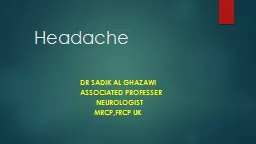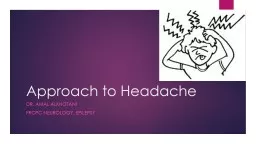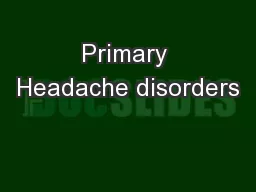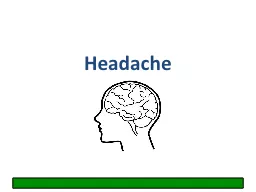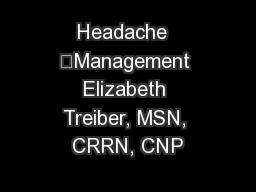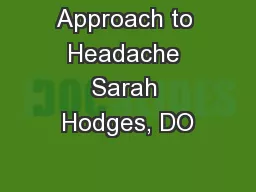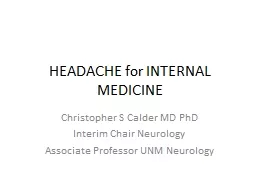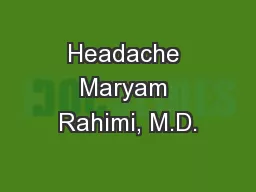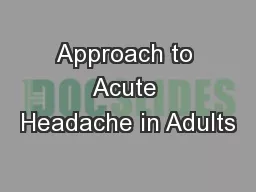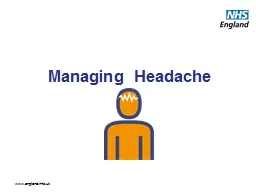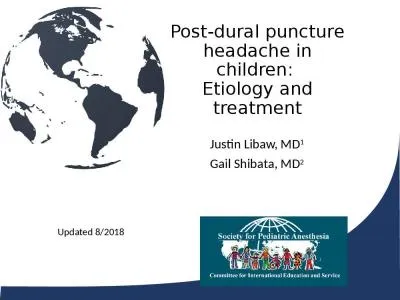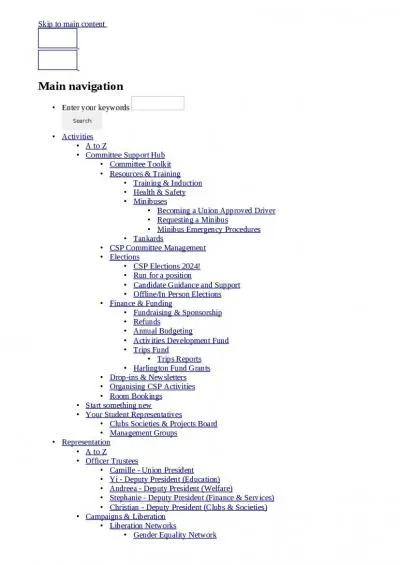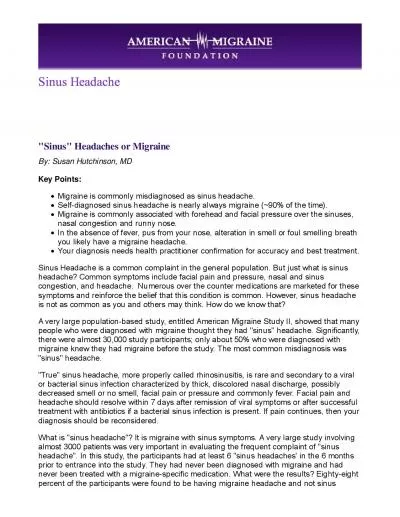PPT-Headache Dr sadik al ghazawi
Author : Outlawking | Published Date : 2022-08-03
Associated professer Neurologist Mrcpfrcp uk Accounts for 1 to 2 of emergency department evaluations and up to 4 of medical office visits Headache is caused
Presentation Embed Code
Download Presentation
Download Presentation The PPT/PDF document "Headache Dr sadik al ghazawi" is the property of its rightful owner. Permission is granted to download and print the materials on this website for personal, non-commercial use only, and to display it on your personal computer provided you do not modify the materials and that you retain all copyright notices contained in the materials. By downloading content from our website, you accept the terms of this agreement.
Headache Dr sadik al ghazawi: Transcript
Associated professer Neurologist Mrcpfrcp uk Accounts for 1 to 2 of emergency department evaluations and up to 4 of medical office visits Headache is caused by traction displacement inflammation or distention of the painsensitive structures in the head or neck. Dr. . Hawar. . Adnan. . Mykhan. M.B.Ch.B. ., F.I.B.M.S. 1. Headache is caused by traction, displacement, inflammation, vascular spasm, or distention of the pain-sensitive structures in the head or neck. . Dr. . amal. Alkhotani. Frcpc. neurology, epilepsy. Headache . Headache is one of the 10 most common reasons for health care visits in USA.. It also account for 4.5% of ER visits.. Types of headache. October 28, 2016. No Disclosures. Primary Headache Disorders. Migraine. Tension. Cluster. Miscellaneous. Headache is the problem, not a symptom of something else. Migraine versus Tension Headache. Migraine is a headache with associated symptoms. Learning objectives . Gain organised knowledge in the subject area of headache. Be able to take a headache history. Know and apply the relevant evidence and/or guidelines . Be . aware of common . errors in . NEONP Conference. April 24, 2015. Disclaimers. Opinions contained in this presentation are the views of the author and do not necessarily reflect the views of the Department of Veterans Affairs. No conflicts of interest. Staff Neurologist. s. arah.d.hodges3.mil@mail.mil. I have no disclosures. A 34-year-old woman came to the office complaining of severe, left-sided throbbing headaches that last about 12–24 hours. She has had these headaches once a week for several months. During an episode, she is sensitive to both bright lights and loud sounds and feels nauseous. Sleep seemed to help her headaches. Neurological examination was normal.. Christopher S Calder MD PhD. Interim Chair Neurology . Associate . P. rofessor UNM Neurology. Conflicts of Interest. I have headaches, literal and figuratively!. I have be an investigator in many clinical trials in the past. . University of California Irvine . Objective. Identify patient who need urgent evaluation and treatment. Review red flags . Primary headache. Secondary headache. Acute treatment. Prophylactic treatment . BARRY L. HAINER, MD, and ERIC M. MATHESON, MD, Medical University of South Carolina, Charleston, South Carolina. Am . Fam. Physician.. 2013 May 15;87(10):682-687.. Journal Review By: SHIRIN BITAJIAN, MD. Managing Headache Headache is an increasing problem Figures for specific CCGs available at: https:// www.gov.uk/government/publications/neurology-services-hospital-activity-data 24% increase in those in treatment for headaches and migraine in the past 5 years Etiology and treatment. Justin Libaw, MD. 1. Gail Shibata, MD. 2. Updated 8/2018. No disclosures. Objectives. Review the epidemiology, etiology and diagnosis of post-dural puncture headache (PDPH). Present risk factors for PDPH. Collapse. - Confusion. - AMTS. Contents. General vs Focused histories. PC. HPC. Characterize the PC . Associated symptoms. ICE. PMHx. DHx. FHx. SHx. Specific risk factors. Headaches . Primary & Secondary. Migraine Program ObjectivesAwareness of the Need for Aggressive Migraine PreventionUnderstand Migraine vs. HeadacheMigraine is a common, disabling disease processClassification of MigraineEpisodic vs. Take-Home Point:Go beyond the nasal and sinus congestion; the facial pain and pressureand look for a headache associated with inability to function normally at work, school, homeor social functions; n
Download Document
Here is the link to download the presentation.
"Headache Dr sadik al ghazawi"The content belongs to its owner. You may download and print it for personal use, without modification, and keep all copyright notices. By downloading, you agree to these terms.
Related Documents

